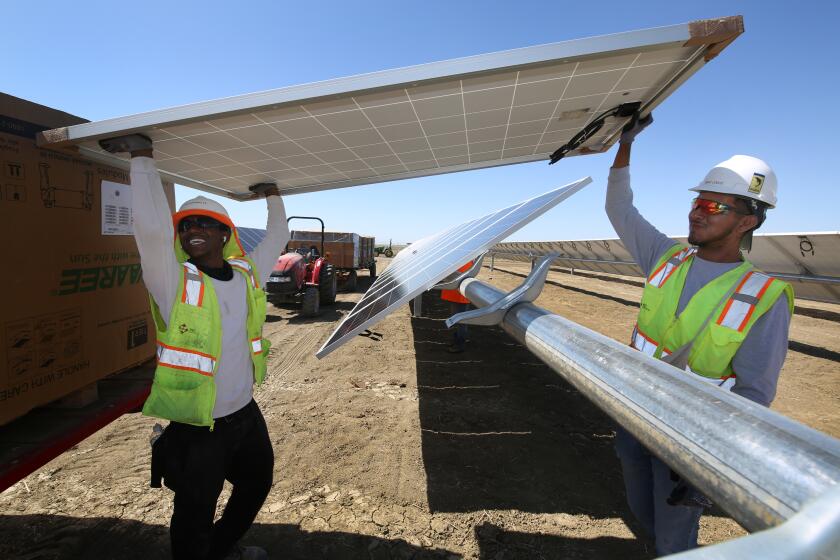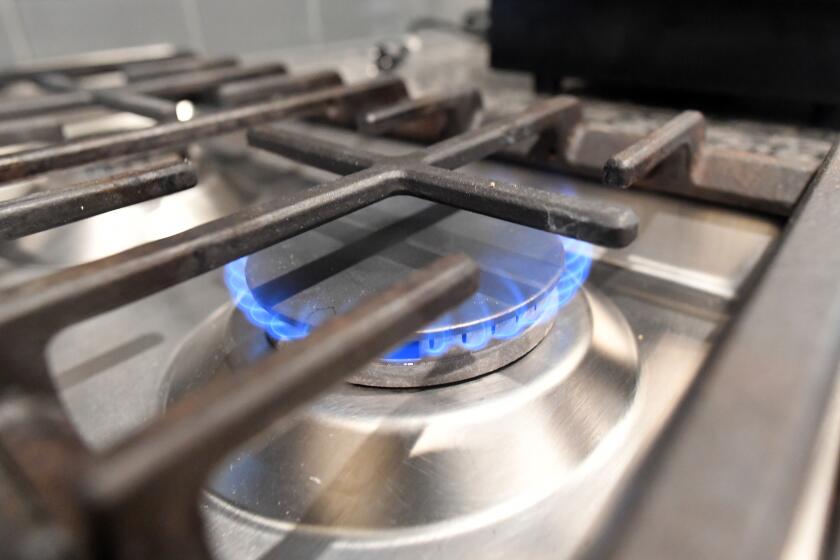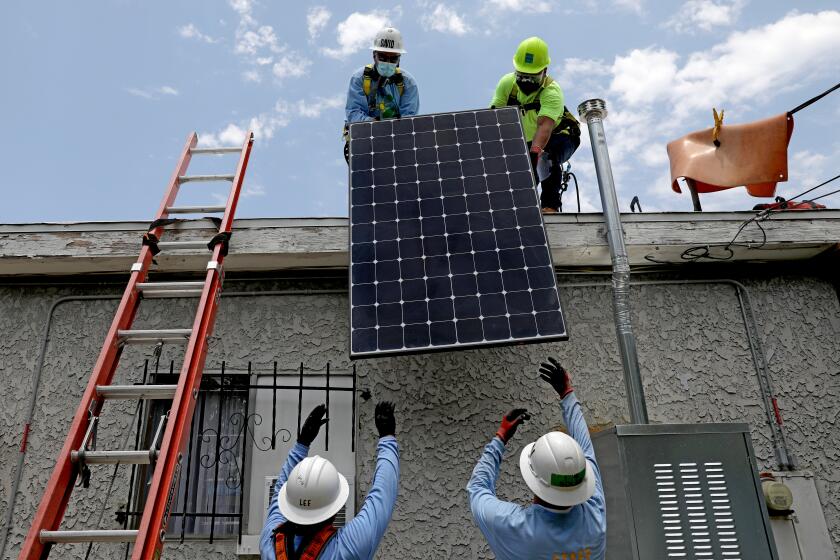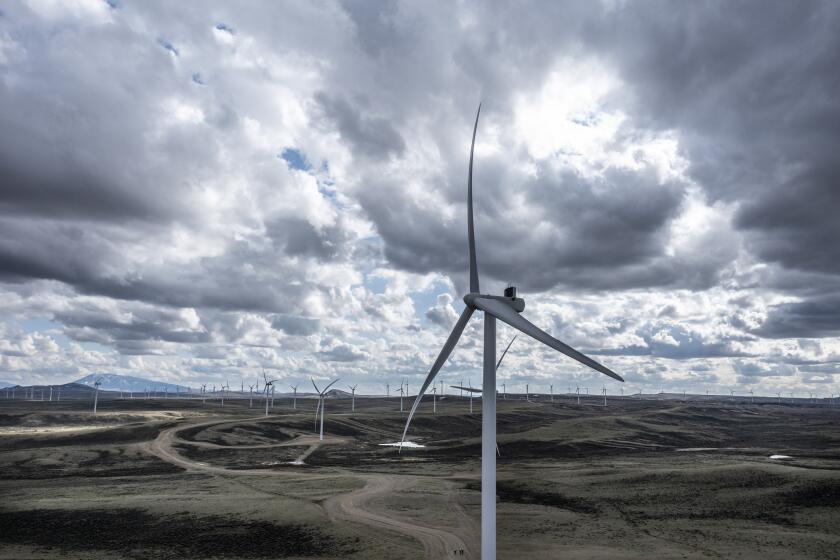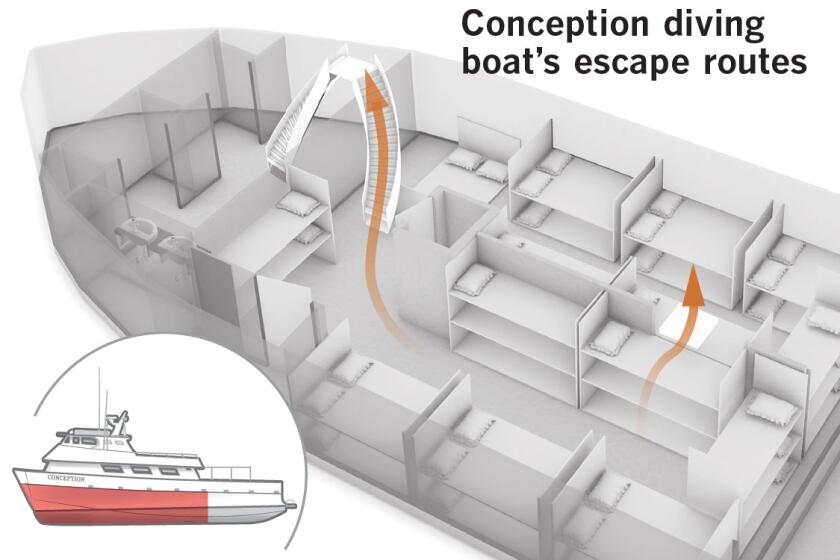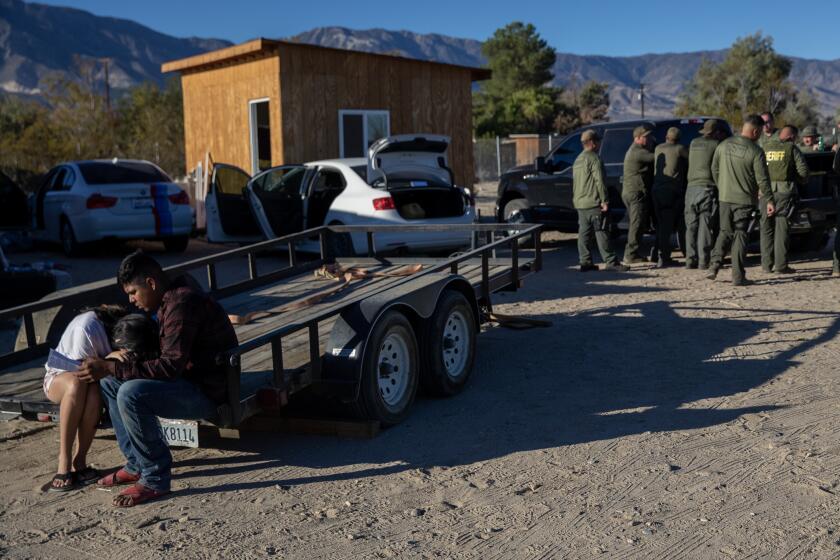California just slashed rooftop solar incentives. What happens next?
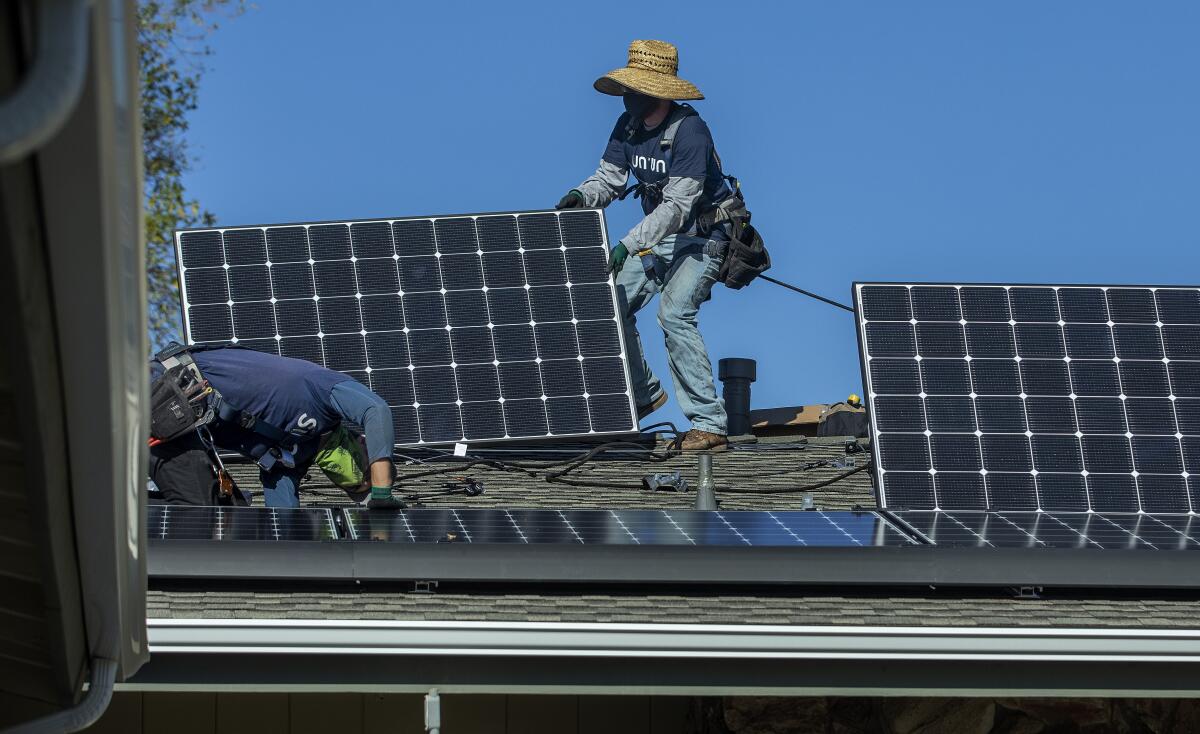
California sharply reduced incentive payments for rooftop solar power Thursday, taking a sledgehammer to a program that helped 1.5 million homes and businesses put solar panels on their roofs and made the state a leader in fighting the climate crisis.
The unanimous vote by the state’s Public Utilities Commission to reduce payments to solar customers for the electricity they generate comes after a decade of controversy over the program. Critics say it has resulted in higher electric bills for households that don’t have rooftop solar panels, including low-income families that can’t afford them.
Solar installers and clean energy activists call that argument flawed, saying the technology’s benefits — including less air pollution in low-income communities, and protection against utility power shutoffs — far outweigh its costs.
But the commissioners rejected their protests, arguing the incentive program needs to change to keep up with the times.
They pointed out that California increasingly has more solar power than it needs during the afternoon — a stark contrast to hot summer evenings when the state has sometimes found itself short on power. They said the revamped incentive program they approved Thursday will encourage more people to install batteries that can bank clean power for those hot evenings.
“California is poised to unlock the next phase of our ambitious climate change agenda, and this decision is part of that,” Commission President Alice Reynolds said. “We’re building a powerhouse of clean energy storage for grid use in the evening.”
The redesigned subsidy program approved by the commission will take effect in April — giving homeowners and commercial businesses that want to install solar under more favorable terms four months to lock in the existing incentives.
Homes and businesses that already have solar won’t see their payments go down. And nothing will change for Los Angeles Department of Water and Power customers who decide to go solar. The decision affects only the rates paid for solar power by the state’s three big monopoly utility companies: Southern California Edison, Pacific Gas & Electric and San Diego Gas & Electric.
Record heat. Raging fires. What are the solutions?
Get Boiling Point, our newsletter about climate change, the environment and building a more sustainable California.
You may occasionally receive promotional content from the Los Angeles Times.
Those companies spent years urging state officials to reduce rooftop solar incentives — as did consumer watchdogs and a handful of environmental groups, which agreed with the utilities that non-solar households have been forced to pay higher bills as a result of the incentive program known as net metering.
On the other side of the debate were the solar industry and hundreds of environmental and community groups. They succeeded in pressuring Gov. Gavin Newsom to block an earlier Public Utilities Commission proposal that was even harsher to rooftop solar, arguing that it was incompatible with the state’s efforts to reverse the worsening wildfires, droughts and heat waves of global warming.
But climate activists still saw the plan adopted Thursday as damaging — only this time, they couldn’t get traction with Newsom.
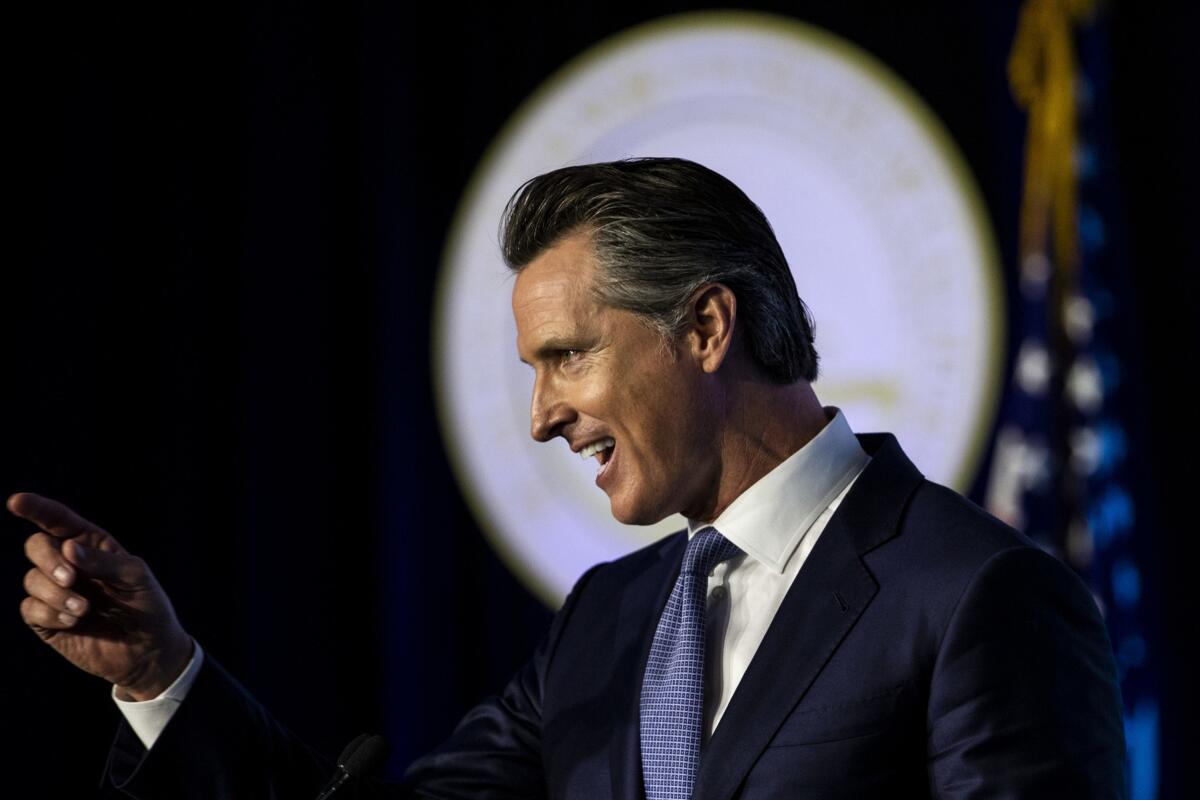
Dozens of solar industry supporters offered public comment before the commission’s 5-0 vote, slamming the agency for siding with the utilities — and at times suggesting Newsom, who appointed four of the five commissioners, was to blame.
Those solar supporters included the Rev. Daniel Tamm, a deacon who spoke on behalf of the Bishop’s Commission on Climate Change, an initiative of the Episcopal Diocese of Los Angeles. He said officials should be working to make rooftop solar “as widely available as possible for all Californians, not crippling it in the economic interests of a few.”
“As faith leaders, our concerns are justice, compassion and the common good. This proposal represents none of that,” he said.
The utility industry wasn’t pleased by Thursday’s vote, either, arguing that the commission should have reduced solar incentives even more. Kathy Fairbanks, a spokesperson for the Affordable Clean Energy for All campaign — which is funded by Edison, PG&E and SDG&E — described the vote as “a missed opportunity that will prolong the harm to low-income Californians and renters.”
“The current solar subsidy program forces low-income families, renters, seniors and anyone who doesn’t have rooftop solar to bankroll wealthier Californians’ solar systems,” she said in an emailed statement.
Endless growth is unsustainable. But we need big solar and wind farms, too.
Newsom’s office declined to comment, outside of a brief reference in a news release noting that the Public Utilities Commission had approved “a new solar policy that will make our grid more reliable and accelerate energy independence.”
So with the long-anticipated vote now in the rearview mirror, what happens next?
Here are six key questions as California’s rooftop solar industry enters a new era — and as the planet keeps warming.
Will fewer people install solar?
The rooftop solar industry has seen nonstop growth in the Golden State for more than a decade. Through the end of October, almost 13,500 megawatts had been installed across California — six times as much energy-generating capacity as the Diablo Canyon nuclear power plant, the state’s single largest source of electricity.
That growth has been fueled by net metering, which compensates solar-powered homes and businesses for the energy they contribute to the larger power grid at times of day when they generate more than they consume. Until now, Edison, PG&E and SDG&E have been required to pay them at retail electricity rates — the same rates they pay for power from the grid.
Under Thursday’s decision, payment rates will vary by the time of day and the time of year — but on average, they’ll be much lower.
Solar industry officials have warned of a market crash that could see smaller installation companies — which make up the bulk of the industry — struggle to survive.
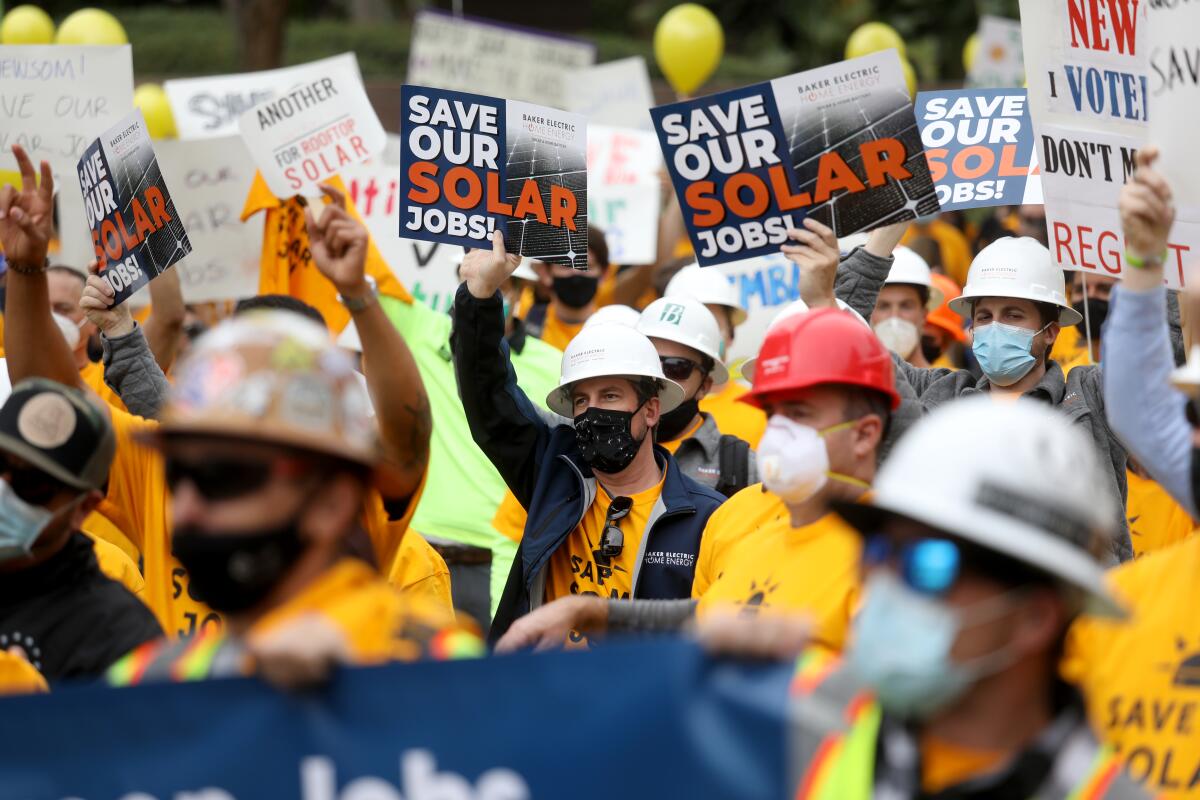
Part of the problem, they say, is that it will take customers too many years to make back their substantial upfront investment in solar panels. For Edison and PG&E customers, the Public Utilities Commission has estimated a “payback period” of nine years under the new rules — far too long for many families to wait for savings, critics say.
“They’re thinking about this as if the whole world is wealthy consumers with money to burn, instead of catering to middle- and low-income communities so we can fricking save this planet,” said Bernadette Del Chiaro, executive director of the California Solar & Storage Assn., an industry trade group.
Supporters of the new incentive program expect the solar industry to respond by finding ways to lower prices, which have stayed relatively flat for the last few years. They also predict the economics of solar will look better than the commission projected — an idea the commissioners themselves endorsed Thursday, suggesting their nine-year payback calculation was conservative.
At least some level of installations is guaranteed, because California requires most newly built homes to include rooftop solar.
Will more people install batteries?
The Public Utilities Commission sure hopes so. Several commissioners said they supported the decision to ensure that more solar is banked for the evenings, when the state currently relies on polluting gas-fired power plants to keep the lights on.
“We are making this change because of our commitment to addressing climate change,” Commissioner John Reynolds said. “If ratepayers are going to subsidize rooftop solar, it must do more to address climate change and meet grid needs.”
Although solar incentive payments will be lower during most times of the day, they’ll be higher in the evening — especially summer evenings when California has flirted with power shortages as rising temperatures drive up the demand for air conditioning.
For homes and businesses that can store solar power in batteries during the day and disperse it at night — helping the state avoid rolling blackouts without cranking up those polluting gas plants — the financial aspect of rooftop solar will look a lot better.
“This a vast improvement on the status quo,” said Matt Baker, who was appointed by Newsom this year to lead the Public Advocates Office, an independent arm of the utilities commission. “For solar going forward, it is targeting exactly what we need to target, which is how do we get solar and battery adoption up to levels like Hawaii has.”
Just 14% of Californians who installed solar over the last year also added batteries, which can bring the upfront investment to about $30,000. The solar industry has been working for several years to pivot to solar-plus-storage, but installers say they need more time to bring battery costs down and to make the financial case for energy storage to consumers.
Support our journalism
Your support helps us deliver the news that matters most. Subscribe to the Los Angeles Times.
Sunrun, the nation’s top rooftop solar installer, is likely to have an easier time adjusting than most. But the San Francisco-based company still foresees challenges, arguing that the utilities commission should have lowered payment rates more gradually.
“The more time you give the industry to get ready, respond, go into action, the more likely it is that we’re not all looking back a year from now talking about how [we] slowed down the clean energy transition,” said Mary Powell, Sunrun’s chief executive.
Will electricity rates go down?
Probably not.
Rates have been rising fast and are expected to keep doing so. For PG&E customers, for instance, base rates for most customers have risen roughly 50% over the last five years, according to data compiled by the Utility Reform Network, a consumer advocacy group. PG&E recently requested another increase that would result in monthly electric bills at least 20% higher by 2026.
Those price shocks have been driven by utility investments to reduce wildfire ignitions, upgrade aging infrastructure and replace fossil fuels with cleaner energy — investments that earn utility shareholders a guaranteed profit of roughly 10% for every dollar spent.
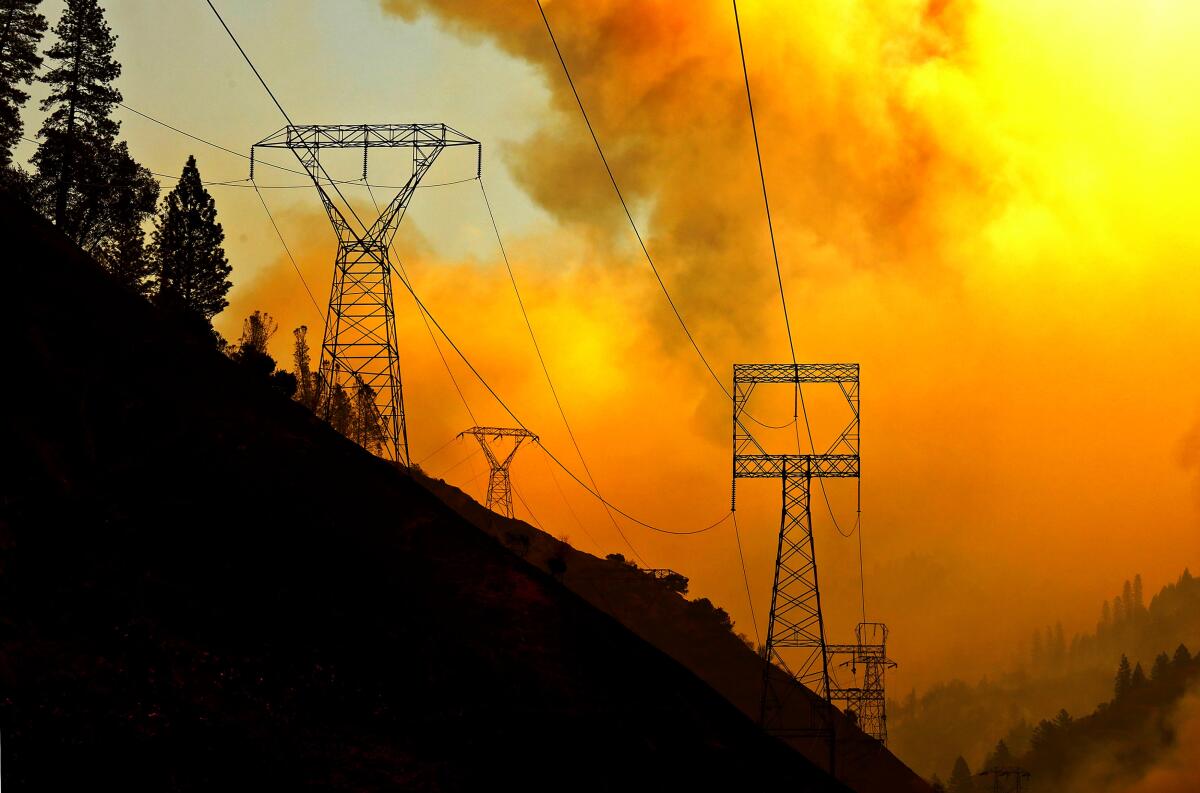
But critics of net metering say the program has contributed to higher energy bills, saddling ratepayers with a $4.6-billion annual subsidy for solar-powered homes and businesses. Reducing the subsidy will limit further rate hikes to an extent, they say.
And the less electricity rates rise, the more likely it is that millions of Californians will replace their gas furnaces and boilers with electric heat pumps, and their gasoline cars with electric vehicles — key technologies for reducing climate pollution.
The commission’s proposal “better aligns signals and incentives across the board,” said Mohit Chhabra, a senior scientist at the Natural Resources Defense Council, one of the few environmental groups that supported Thursday’s decision.
Climate change spurred Friday’s unanimous vote by the Los Angeles City Council.
Other climate activists dismiss the idea that net metering causes higher energy bills, saying state officials underestimate the benefits that rooftop solar brings to all ratepayers — including less need for utilities to build expensive long-distance power lines.
How will low-income homes be affected?
Almost everyone involved in the net metering debate thinks it should be easier and cheaper for low-income families to install solar panels and batteries. But how much the new payment system will help them is a matter of fierce debate.
Under the new solar rules, low-income homes enrolled in subsidized rate programs will receive higher payments for solar power they export to the grid — as will all homes in disadvantaged communities and on tribal lands, a last-minute change approved by the utilities commission. But environmental justice activists say those higher payments are still much too low.
“It’s not enough to really expand low-income customer access,” said Katie Ramsey, an attorney with the Sierra Club. “The goals they’re stating are good, but the implementation is really risky — particularly the fact that the export values drop so sharply.”
The commission’s decision also refers to an expected $900 million in new upfront incentive payments for rooftop solar and battery systems, with two-thirds of that money set aside for low-income homes. But state lawmakers still need to allocate those funds next year — and with a possible recession on the horizon, solar supporters aren’t sure the money will materialize.
Federal data show that 12% of California solar adopters in 2021 had incomes below $50,000, and an additional 28% had incomes between $50,000 and $100,000. Renewable energy advocates will be watching to see whether those numbers rise. They’ll also be looking to state officials to do more to bring solar power to the roughly 45% of Golden State residents who rent their homes.
Clean energy activists and utility giants are duking it out over the future of rooftop solar.
But as for net metering? The program’s critics insist that it’s done more harm than good for low-income families.
“It’s just an upside-down Robin Hood thing going on,” said Pedro Pizarro, chief executive of Edison International, the parent company of Southern California Edison. “It’s just such a massive transfer of wealth, and it’s getting bigger.”
Will California build more large solar farms?

Not all renewable energy is created equal — at least not in the eyes of some environmentalists.
The fewer solar panels are installed on residential rooftops, warehouses and parking lots, the more large solar farms, wind turbines and long-distance transmission lines may be needed — a huge concern for conservation groups who say that infrastructure can damage sensitive ecosystems and harm at-risk creatures such as desert tortoises and bighorn sheep.
“We need to leverage renewable energy options with the least impact on pristine and functioning ecosystems,” Susy Boyd, public policy coordinator for the Mojave Desert Land Trust, told the Public Utilities Commission on Thursday.
Some experts caution that there’s not necessarily a 1-1 ratio between less solar on rooftops and more in the desert, considering the huge amounts of infrastructure that California will need to reach 90% clean electricity by 2035 and 100% by 2045, as required by state law. They also note that power from large solar farms is typically cheaper due to economies of scale.
More construction of large solar farms — and power lines to serve those solar farms — could also benefit another constituency: organized labor. Union workers employed by solar developers and utilities are a powerful force, and they’ve pushed state officials to promote large-scale clean energy infrastructure at the expense of rooftop solar jobs, which are typically non-union.
“We need to raise the level and quality of jobs throughout the economy,” said Marc Joseph, an attorney representing the Coalition of California Utility Employees. “We shouldn’t have people who are on the fringe struggling, holding on desperately to try to be in the middle class, when we could otherwise have them be comfortably in the middle class.”
Billionaire Phil Anschutz — who owns the Coachella music festival, the Los Angeles Kings hockey team and L.A.’s Crypto.com Arena — is preparing to build the nation’s largest wind farm. We traveled the route.
What does this mean for the climate fight?
Rooftop solar is just one piece of the puzzle when it comes to phasing out fossil fuels. Offshore wind turbines, geothermal plants, nuclear reactors, energy efficiency, green hydrogen, electric cars, electric heat pumps — some combination of these strategies and more will almost certainly be needed to refashion economies currently underpinned by coal, oil and natural gas.
But rooftop solar is one of the most visible climate solutions in neighborhoods across the country — and a wildly successful one, with falling costs spurring growing installations.
And California is seen as a global climate leader. If rooftop solar installations fall here, and state officials don’t step in to arrest the decline, other states could be more likely to follow the same path.
Rooftop solar “has added jobs, brought new investment and created greater resiliency for the grid and for emergencies. There’s a reason Los Angeles is the No. 1 solar city,” said Mary Leslie, president of the Los Angeles Business Council.
Your guide to our clean energy future
Get our Boiling Point newsletter for the latest on the power sector, water wars and more — and what they mean for California.
You may occasionally receive promotional content from the Los Angeles Times.
On the other hand, if policymakers can’t get electric rates under control, other states and countries may decide that following California’s lead on electric vehicles — including a ban on the sale of most new gasoline cars by 2035 — isn’t wise.
“We should be aiming for a world where you can have 50% of customers with rooftop solar, and it won’t increase electricity rates for everybody else,” said Matthew Freedman, an attorney at the San Francisco-based Utility Reform Network.
The debate didn’t end with Thursday’s decision.
In a separate regulatory proceeding, the Public Utilities Commission is considering a broader restructuring of electricity rates in an effort to keep costs down, avoid blackouts and continue reducing climate pollution. That proceeding could result in new monthly charges for solar-powered homes — and most other utility customers.
The only certainty: Thursday’s vote wasn’t the last hard climate decision California officials will have to make.
L.A. Reads
L.A. Guides
More to Read
Inside the business of entertainment
The Wide Shot brings you news, analysis and insights on everything from streaming wars to production — and what it all means for the future.
You may occasionally receive promotional content from the Los Angeles Times.
